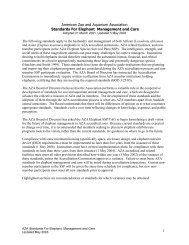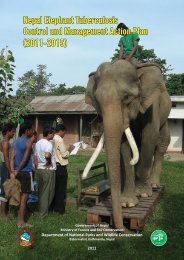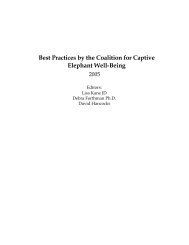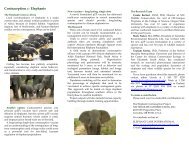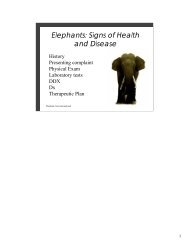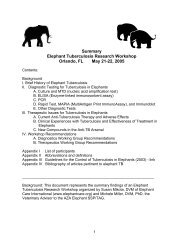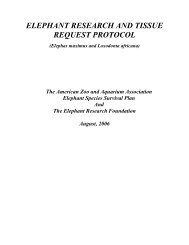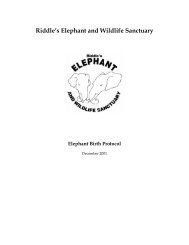Elephants Elephants - Wildpro - Twycross Zoo
Elephants Elephants - Wildpro - Twycross Zoo
Elephants Elephants - Wildpro - Twycross Zoo
- No tags were found...
Create successful ePaper yourself
Turn your PDF publications into a flip-book with our unique Google optimized e-Paper software.
most of the animals have been wild caught and most breeding is from matingsbetween domestic cows and wild bulls. Working elephants have not been thesubject of sustained captive breeding, nor have they been selected forparticular characteristics. It is therefore inaccurate to refer to the Asianelephant as a domesticated species. African elephants have a reputation ofbeing more difficult to train than Asian (Mellen and Ellis 1996) howeverelephants have been trained to work in what is now the Democratic Republicof Congo since Belgium colonial times (Bridges 1947) (Hillman Smith 1992)(Wager 1954) (Caldwell 1927) and are still used in the Garamba National Park(Hillman Smith 1992).Man has hunted the elephant since prehistoric times; it is known that stoneageman hunted the mammoth, mainly for use of meat and skin. Moreprimitive methods involved pit traps, poisoned arrows, harpoons and evenswords, but it was the advent of the rifle that heralded the start of the seriousdecline of elephant populations. Elephant carcasses are put to many uses:food, oil, hair is made into bracelets and the skin can be manufactured intomany objects from shields to clothing and furniture. <strong>Elephants</strong> became extinctin Syria in the first millennium BC due to excessive hunting. From the firstdays of civilization ivory has been in great demand. It is mentioned in theBible and was much treasured in ancient Greece and Rome, its consumption inEurope was enormous. The Menageries (1831) quote 364,784 lbs of ivorybeing imported into England in 1827, representing at the very minimum, thedeaths of 3,040 elephants. More recent is the advent of sport hunting, withlicences being sold to hunters (Redmond 1996) and this forms part of theongoing debate over sustainable use of elephants in some African countries.Not only has man hunted the elephant, he has used it as a means of transportto hunt other animals, notably in magnificent hunting expeditions by Indianprinces, when hundreds of elephants could be used. All animals weretargeted from antelope to leopard, buffalo and tiger, although the elephantwas most frequently employed in India in tiger hunts [Menageries 1931 #30]and there are several accounts of tigers fighting back and attacking thetransporting elephant.Assurnasirpal II (King of Assyria) established a zoo in the ninth century BCwith elephants he had captured in Syria; Alexander the Great kept elephantsin the Macedonian court. However it was the Romans that started to useelephants in the amphitheatre as circus performers. They fought each other,bulls and even armed men. Elephant baiting was also a popular sport in Indiaand other Asian countries as was elephant / tiger and lion fights (Carrington1962) [Menageries 1931 #30]. In Roman times they were also taught toperform and even to throw arrows and walk on tight-ropes. Both Caeser andClaudius are reputed to have brought elephants to England [Menageries 1931#30]. The first elephant to reach England since Roman times was in the 13 thcentury, as mentioned in the Introduction but it was not until the 16 th centurythat elephants became more common in western Europe; notable animalswere the one at Clerkenwell Green in London in the mid 17 th century and theone burnt to death in Dublin around the same time. By the nineteenth centurythey were a familiar sight in zoos and, when the menagerie in the Tower wasclosed, an elephant from there was passed on to the newly formed collectionin Regent’s Park, which opened in 1829. The first Asian elephant was brought34




